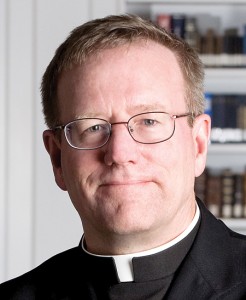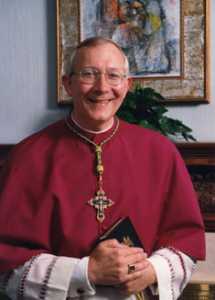 If the Catholic priesthood and its renewal is very important to you, then today’s brief essay by Archbishop Gerhard Ludwig Müller is an extremely important piece to keep in mind. The essay by Prefect of the Congregation of the Doctrine for the Faith, Archbishop Müller, “Beyond the crisis towards renewal” (L’Osservatore Romano) reveals a point the Church has to attend to with a certain degree of seriousness. Pay close attention to the proposal Müller makes to us. What the archbishop is doing, I think, is opening the door to genuine dialogue on some very important issues, and I think within the purview of the Holy Father.
If the Catholic priesthood and its renewal is very important to you, then today’s brief essay by Archbishop Gerhard Ludwig Müller is an extremely important piece to keep in mind. The essay by Prefect of the Congregation of the Doctrine for the Faith, Archbishop Müller, “Beyond the crisis towards renewal” (L’Osservatore Romano) reveals a point the Church has to attend to with a certain degree of seriousness. Pay close attention to the proposal Müller makes to us. What the archbishop is doing, I think, is opening the door to genuine dialogue on some very important issues, and I think within the purview of the Holy Father.
Müller wants to challenge our “Protestant” conceptions of priesthood that’s found its way into the reality of Catholic priesthood. Some will be offended by the archbishop’s use of the adjective of protestant but in reality there is much to research here to overcome perceived prejudicial reactions. Protestants are not the same as Catholics; they were there wouldn’t be a so-called “Protestant Church.” Catholics ought to be better formed and have certitude in this fact.
Based at least on the level of experience, and not only academic theology, men are ordained Catholic priests to offer the sacrifice of the Mass, to forgive sins, and to concern itself: that is, cult (worship of the One Triune God) and mediatorship, theological points rejected in Lutheranism, Anglicanism and other ecclesial communities. Do we have to remind ourselves that a Catholic priest acts in persona Christi capitis? That he does indeed consecrate, through prayer and the actions of the Holy Spirit, bread and wine into the body and blood, soul and divinity of Jesus Christ? That the laity consecrate the whole world (marriage, work, play, etc.) to Jesus Christ. The local Lutheran minister does not hold the same, so not teach the distinctions with clarity?
The matter is not centrally located in the question of a married priesthood because the discernment of ordination and celibacy is not the same. The Catholic Church has a married priesthood with former Anglican ministers coming into full communion with the Catholic Church and being ordained, and there are married Eastern Catholic priests. Hence, believe that Catholic priests are not the same as Protestant ministers, even if those of other ecclesial communions use the word “priest” to speak of their ministers.
Additionally, Catholic priests belong to the Royal Priesthood of Jesus Christ, as the laity are, each being anointed priest, prophet and king, yet lived and oriented differently. To refine the point a little more, the global priesthood, that is, the priesthood of the laity, and the ministerial priesthood have their respective vocations given by the Holy Spirit for the good of the world. Admittedly, the priesthood of the laity (priesthood of the faithful) is still maturing and only now coming into its own but not against the ministerial priesthood.
The Church’s theology is based on sacred Scripture and sacred Tradition. Catholic theology has its own determinative lens and other communities have theirs. In a more precise way, we have a theology prima that’s not found in the protestant communities. I use the plural communities because the what is understood as a priest is different depending which group you follow.
The publication of Müller’s brief essay today is not to be lost on us: on this date in 1517 Augustinian Father Martin Luther posted his ninety-five theses, in Latin, on the Wittenburg Church door according to custom.
What we have are excerpts from a speech the Prefect delivered on Wednesday in Palermo for the introduction of the 12-volume collected writings of Joseph Ratzinger (scheduled for publication first in Italian). The editor was just given the now-famed Ratzinger prize.
Müller’s point is the Catholic priesthood started to develop a “Protestant” of the image/manner of serving when Catholics uncritically started to use Protestant scripture scholarship since the 1950s without noting essential theological differences. Ratzinger’s phrase “culture of relativism” entered into Catholic teaching dismissing the eschatalogical, soteriological and liturgical facts.
What we’ve inherited, and what we see in the priesthood today, at least here in the USA, is indeed a crisis of priesthood which leads to a “radical disorientation of Christian identity” and a manner of knowing that lacks a “transcendental horizon.”
The following is an excerpt of a longer piece.
If Christ, by his Resurrection, has overcome the greatest crisis of faith –the pre-Easter crisis of the disciples– and more particularly the crisis of the apostolic mission and authority, and therefore also of the Catholic priesthood, then it is precisely and only by turning our gaze to the Lord that we may also overcome the crises which have befallen the priesthood over the course of history.
By turning our gaze to him, by meeting his gaze as he looks upon us and upon our priesthood, and by fixing our eyes on those of the crucified and risen High Priest, we can overcome every obstacle and difficulty.
I am thinking especially of the crisis of the doctrine on the priesthood that occurred during the protestant Reformation. It was a crisis at the dogmatic level which reduced the priest to a mere representative of the community by eliminating the essential difference between the ordained priest and the common priesthood of the faithful. Then there was the existential and spiritual crisis that occurred during the second half of the 20th century and exploded after the Second Vatican Council, and from whose consequences we are still suffering today.
In Joseph Ratzinger’s extensive work Proclaimers of the Word and Servants of Your Joy – volume XII in his opera omnia – he proposed a way of overcoming these crises by advancing a high-level theological approach, thereby giving us a guide for fostering a renewal of the sacramental priesthood instituted by Christ.
The scientific studies, meditations and homilies on the service of bishops, priests and deacons contained in this volume span almost fifty years, beginning with the years immediately preceding the beginning of Vatican II.
Many people, depending on their respective positions, associate this event, which has marked the recent history of the Church more than any other, with the starting point of a transformation in keeping with the spirit of the times, or rather with the beginning of a profound crisis in the Church and in particular in the priesthood.





